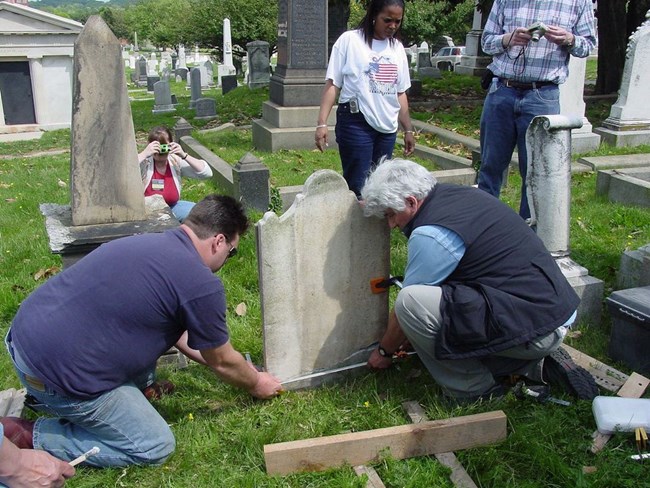Last updated: April 7, 2025
Article
Cemetery Conservation Terms & Definitions

National Park Service
Structures
Marker
A sign or indication of a burial placed at the head of the body.
Footstone
Sign or indication of a burial placed at the foot of the body, usually smaller.
Box Tomb/Basal
Box shaped monument built above ground; burial usually takes place below ground, usually about 3’ by 6’ and 2’-3’ high.
Vault
Burial chamber, commonly below ground.
Mausoleum
Large structure or building built above ground for burials.
Bedstead
Resembles the framework of a bed with side pieces and end pieces in addition to marker. Obelisk – stone pillar with a rectangular cross section tapering towards a point (Example Washington Monument).
Materials
Marble
A hard usually white rock with visible crystals that fizzes with a drop of vinegar. This metamorphic rock contains calcium and is usually polished.
Limestone
This medium to soft rock consists mainly of calcium, and is white to buff color. It also fizzes with vinegar or other acids.
Granite
This igneous rock has visible medium to large crystals, usually grey in color but commonly found in pink, red, or black.
Slate
A fine-grained metamorphic rock, with naturally smooth finish that tends to separate along bedding planes, commonly a grayish color.
Sandstone - (also known as Brownstone)
A sedimentary rock consisting of sand consolidated with binder, porous and easily worked, and susceptible to separating.
Schist
Metamorphic rock with banded layer and medium crystals, color is streaky, silver, black, white, and green.
Brick
Used in foundations for markers and construction of monuments, historically pointed with lime-based mortar although if it was repointed a Portland based mortar possibly (and incorrectly) used.
Wood
Produced from trees, this material is used commonly in fences and markers, deteriorates much more quickly than stone.
Cast Iron
An iron-based metal that is fabricated in sections and bolted together, cast in a mold allowing for greater detail. Sections are usually bolted together.
Wrought Iron
An iron based metal that is shaped by forging allowing for more delicate pieces, lighter than cast iron.
Bronze
A copper and tin metal alloy that usually forms a brown or possibly green patina.
Lead
A soft malleable metal with several historical uses including to hold fence pieces together or in place, to shim stones, and cast in sculpture.
Zinc (White Bronze)
Cast metal that has a bluish color and is very durable.
Concrete
Lime or Portland cement based used in construction and markers themselves, concrete markers often with a less refined appearance.
Glass
Commonly found as windows in mausoleums, may be leaded or stained glass.
Coatings
Limewash
Finish made from lime and water used to protect surfaces.
Cement Wash
More modern wash with a cement additive.
Stucco
Finish made from sand, water, and lime to coat exterior, also concrete stucco. Paint – pigment suspended in liquid used to coat a surface.
Types of Damage
Collapse
Loss of structural integrity.
Fallen
Monument is not in its original position.
Broken
Forcibly separated into pieces.
Missing Pieces
Parts of the stone are no longer there.
Stained Surface
Surface shows signs of stains that can not be removed with water alone.
Biological Growth
Lichen, mold, or mildew found on the surface.
Erosion
Areas have been removed by wind or water.
The National Center for Preservation Technology and Training (NCPTT) publishes articles on a variety of historic preservation topics, including disaster preparation, mitigation, and recovery.
